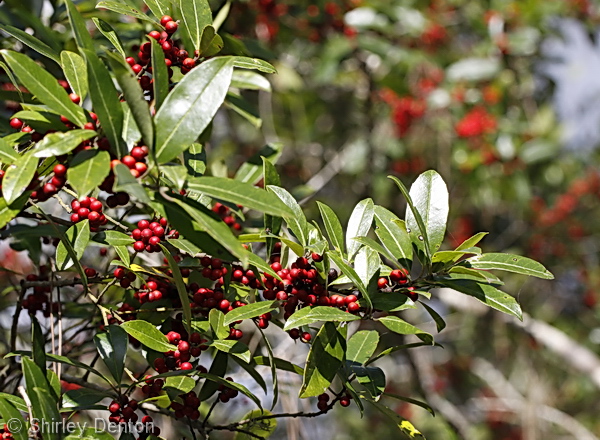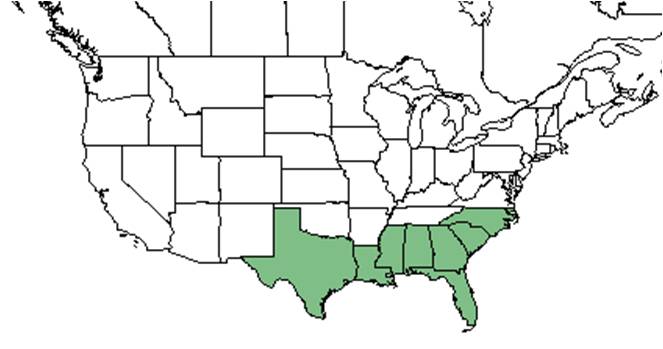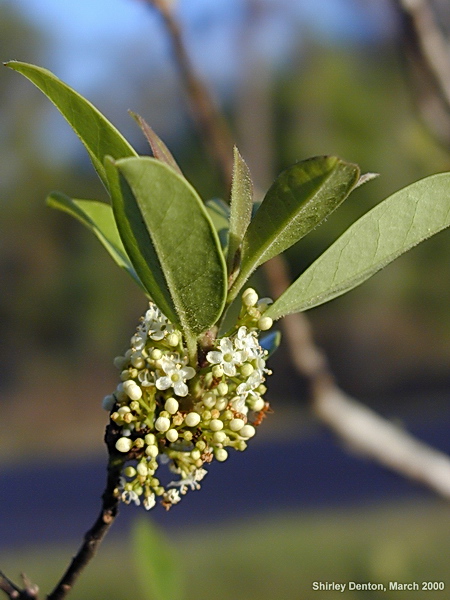Difference between revisions of "Ilex cassine"
Laurenloria (talk | contribs) |
|||
| Line 32: | Line 32: | ||
<!--===Habitat===--> <!--Natural communities, human disturbed habitats, topography, hydrology, soils, light, fire regime requirements for removal of competition, etc.--> | <!--===Habitat===--> <!--Natural communities, human disturbed habitats, topography, hydrology, soils, light, fire regime requirements for removal of competition, etc.--> | ||
===Phenology=== <!--Timing off flowering, fruiting, seed dispersal, and environmental triggers. Cite PanFlora website if appropriate: http://www.gilnelson.com/PanFlora/ --> | ===Phenology=== <!--Timing off flowering, fruiting, seed dispersal, and environmental triggers. Cite PanFlora website if appropriate: http://www.gilnelson.com/PanFlora/ --> | ||
| − | + | ''I. cassine'' has been observed flowering in December.<ref>Nelson, G. [http://www.gilnelson.com/ PanFlora]: Plant data for the eastern United States with emphasis on the Southeastern Coastal Plains, Florida, and the Florida Panhandle. www.gilnelson.com/PanFlora/ Accessed: 12 DEC 2016</ref> | |
<!--===Seed dispersal===--> | <!--===Seed dispersal===--> | ||
<!--===Seed bank and germination===--> | <!--===Seed bank and germination===--> | ||
<!--===Fire ecology===--> <!--Fire tolerance, fire dependence, adaptive fire responses--> | <!--===Fire ecology===--> <!--Fire tolerance, fire dependence, adaptive fire responses--> | ||
| + | |||
===Pollination=== | ===Pollination=== | ||
The following Hymenoptera families and species were observed visiting flowers of ''Ilex cassine'' at Archbold Biological Station: <ref name="Deyrup 2015">Deyrup, M.A. and N.D. 2015. Database of observations of Hymenoptera visitations to flowers of plants on Archbold Biological Station, Florida, USA.</ref> | The following Hymenoptera families and species were observed visiting flowers of ''Ilex cassine'' at Archbold Biological Station: <ref name="Deyrup 2015">Deyrup, M.A. and N.D. 2015. Database of observations of Hymenoptera visitations to flowers of plants on Archbold Biological Station, Florida, USA.</ref> | ||
Revision as of 20:05, 2 November 2018
| Ilex cassine | |
|---|---|

| |
| Photo by Shirley Denton (Copyrighted, use by photographer’s permission only), Nature Photography by Shirley Denton | |
| Scientific classification | |
| Kingdom: | Plantae |
| Division: | Magnoliophyta - Flowering plants |
| Class: | Magnoliopsida - Dicotyledons |
| Order: | Celastrales |
| Family: | Aquifoliaceae |
| Genus: | Ilex |
| Species: | I. cassine |
| Binomial name | |
| Ilex cassine L. | |

| |
| Natural range of Ilex cassine from USDA NRCS Plants Database. | |
Common name: Dahoon
Contents
Taxonomic notes
Synonym: Ilex cassine var. cassine
Description
“Trees or shrubs, usually with imperfect flowers. Leaves simple, entire, serrate, dentate or crenate; stipules obsolete. Flowers axillary, solitary, fascicled or in cymes, 4-7 merous, 4-8 mm broad; petals united at the base, imbricate in bud; pistillate flowers usually with nonfunctional stamens; anthers opening lengthwise; stigmas 4-7, essentially sessile. Drupe red, black or rarely yellow or white. Seeds with hard, bony endocarp (pyrenes), often grooved or ribbed on the back, 4-7 in a fruit, 1 in each locule.” [1]
"Large shrub or small tree, twigs minutely pubescent. Leaves coriaceous, lustrous above, pubescent beneath, at least on the midrib, evergreen, elliptic to obovate to oblanceolate or lanceolate, 2-10 cm long, 0.3-3 cm wide, remotely serrulate, serrate, or entire, often revolute. Pedicels usually densely canescent. Staminate flowers in short, axillary compound cymes, 4-merous. Pistillate flowers solitary or in 3-flowered, pedunculate cymes, in the leaf axils or from nodes just below the leaves; 4-merous. Drupe red, occasionally yellow or orange, lustrous, globose, 5-8 mm in diam.; pyrenes 4, irregularly grooved on the back, 4-5 mm long." [1]
Distribution
Ecology
Phenology
I. cassine has been observed flowering in December.[2]
Pollination
The following Hymenoptera families and species were observed visiting flowers of Ilex cassine at Archbold Biological Station: [3]
Apidae: Epeolus zonatus
Colletidae: Colletes brimleyi, Hylaeus confluens
Halictidae: Augochlora pura, Augochlorella aurata, A. gratiosa, Lasioglossum placidensis, Sphecodes heraclei
Leucospididae: Leucospis affinis, L. slossonae
Megachilidae: Coelioxys sayi, Heriades leavitti
Pompilidae: Anoplius marginalis, A. parsoni, Aplopus mellipes, Episyron conterminus posterus, Paracyphonyx funereus, Psorthaspis legata
Sphecidae: Cerceris flavofasciata floridensis, C. rufopicta, Crabro hilaris rufibasis, Ectemnius decemmaculatus tequesta, Epinysson basilaris, Gorytes dorothyae ruseolus, Isodontia auripes, I. mexicana, Liris muesebecki, Oxybelus decorosum, O. emarginatus, O. laetus fulvipes, Tachysphex similis, Xysma ceanothae
Vespidae: Mischocyttarus cubensis, Pachodynerus erynnis, P. nasidens, Parancistrocerus perennis anacardivora, P. salcularis rufulus, Polistes bahamensis, P. bellicosus, P. metricus, Stenodynerus lineatifrons, Vespula maculifrons, V. squamosa, Zethus slossonae, Z. spinipes
Conservation and management
Cultivation and restoration
Photo Gallery
Flowers of Ilex cassine, Photo by Shirley Denton (Copyrighted, use by photographer’s permission only), Nature Photography by Shirley Denton
References and notes
- ↑ 1.0 1.1 Radford, Albert E., Harry E. Ahles, and C. Ritchie Bell. Manual of the Vascular Flora of the Carolinas. 1964, 1968. The University of North Carolina Press. 679-81. Print.
- ↑ Nelson, G. PanFlora: Plant data for the eastern United States with emphasis on the Southeastern Coastal Plains, Florida, and the Florida Panhandle. www.gilnelson.com/PanFlora/ Accessed: 12 DEC 2016
- ↑ Deyrup, M.A. and N.D. 2015. Database of observations of Hymenoptera visitations to flowers of plants on Archbold Biological Station, Florida, USA.
